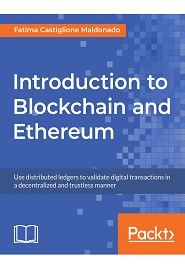
English | 2018 | ISBN: 978-1789612714 | 102 Pages | EPUB | 10 MB
Build distributed applications that resolve data ownership issues when working with transactions between multiple parties
Blockchain applications provide a single-shared ledger to eliminate trust issues involving multiple stakeholders. With the help of Introduction to Blockchain and Ethereum, you’ll learn how to create distributed Blockchain applications which do not depend on a central server or datacenter. The course begins by explaining Bitcoin, Altcoins, and Ethereum, followed by taking you through distributed programming using the Solidity language on the Ethereum Blockchain. By the end of this course, you’ll be able to write, compile, and deploy your own smart contracts to the Ethereum Blockchain.
What you will learn
- Grasp Blockchain concepts such as private and public keys, addresses, wallets, and hashes
- Send and analyze transactions in the Ethereum Rinkeby test network
- Compile and deploy your own ERC20-compliant smart contracts and tokens
- Test your smart contracts using MyEtherWallet
- Create a distributed web interface for your contract
- Combine Solidity and JavaScript to create your very own decentralized application
Resolve the captcha to access the links!